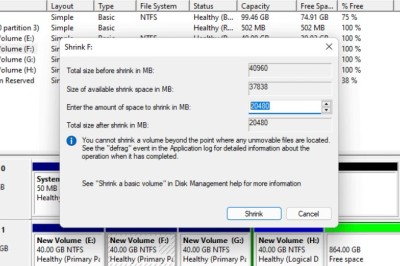views
You’re thinking about launching a business blog, but don’t know where to start? We’ve got you covered!
Starting a blog can be a challenge, especially for first-timers, but it's far from complicated. You just need to create a strategy that will take you through the process one step at a time. You need a detailed plan, a list of resources, and goals you need to achieve to get your business blog up and running. And, this is exactly what we'll teach you in this article.
Below, you’ll find a step-by-step guide on how to start a small business blog. Let’s break it down.
source: Pexels
1.Choose a Blogging Platform
First things first, you need to consider which blogging platform you're going to use. You need one to create and manage your future blog.
WordPress is definitely the most popular and widely-used blogging platform that powers 43% of all websites today. People love it because it's free, comes with a ton of free templates, and allows you to manage every aspect of your blog. You will need to go through a learning period to master using WordPress, but luckily, you’ll find tons of tutorials and guides online.
Still, you should do additional research and find out what other platforms have to offer.
2.Get Hosting
Next, you need to find hosting for your blog, that is- a reliable hosting provider.
Hosting refers to the online space that you’ll be using to upload and publish your website. You need it to put your blog out there, manage it, collect data, and more. And, you need to make sure the hosting provider that you choose:
- is trustworthy and on the market for at least a couple of years
- provides 24/7 customer support
- offers different features you may need to use
With a reliable hosting provider, you’ll be certain your blog will be running smoothly.
3.Consider Your Niche
You know you want to be in the business niche, but you don’t want your blog to be too generalized. It may seem like the wider the topics you cover, the wider your audience. But, it’s always better to narrow things down.
If you select a more precise niche, you’ll have bigger chances to win over the readership that is interested in those specific topics.
You could choose to specialize in:
- business in a certain industry
- marketing for small businesses
- family-owned businesses
- start-ups
- management in business
Consider what your specific niche will be and decide which direction you want to head with your blog.
4.Outline Some Topics
Next, you’ll need to go into even more detail and plan the content of your future blog. You’ve got your niche and a target audience you’re aiming at. Now, you need to decide what topics you want to cover and what goals you want to achieve with your business blog.
Let’s say you’ve decided you’ll focus your blog on start-ups. Now, you need to decide what you want to write about in this niche. For instance, you could go for:
- the latest news in the start-up world
- interviews with successful start-up founders
- advice on starting, managing, and running a start-up
- funding
Create an outline that will help you imagine what your blog will look like once it’s launched.
5.Choose a Name and Domain Name
Now that you've covered all the essentials, you can finally select a name for your blog and a domain name to register it under. Make sure the name is unique but also reveals the content of the blog at the same time.
Let’s take a look at the names of some of the world’s most popular business blogs:
- Entrepreneur
- Business Insider
- Small Business Trends
- TechCrunch
- FastCompany
You get the idea, right?
Once you select a name, you’ll need to see if the domain name is available for you to register. If it is, you’re all set and ready to start working on your content.
6.Consider Different Content Types
Apart from choosing the right topics, you also need to choose how you’re going to cover them. The content format you decide to use will heavily influence your readership and engagement.
First, you can experiment with different content types. Once you see what gets you the most attention and what your followers are enjoying the most - you can focus on that specific content type.
Here’s what you could try out:
- interviews with experts, influencers, and knowledgeable people
- how-to articles
- guides and tutorials
- top lists
- updates and news
- reviews
Think about the types of content your audience might prefer, and give it a chance.
7.Start Writing
Now it’s finally time to start writing! After all the preparation and hard work, you get to do what you like the most-write about your favorite business topics.
Choose one topic to cover, and make sure you do it like a pro:
- create an outline
- develop it slowly
- add relevant information
- rely on credible sources
- edit several times
If it feels like too much to handle at first, you can find help at Trust My Paper. Their professional writers can do the editing for you until you gain the confidence to do it yourself. You should also find a friend or a colleague you trust, to take a look at your writing before publishing.
8.Learn How to Create Visuals
A great business blog needs great visuals. Although the written content should be the main focus, it needs the support of the right visuals to help it stand out and grab the attention of the readers.
You should learn how to create visuals such as:
- blog banners
- cover images
- infographics
- tables
- charts
You can start by using Canva, a free graphic design tool that comes with a ton of free templates you can use. Later on, you could move to more complex tools and further update your visuals or outsource someone to do it for you.
9.Learn About Link Building
Link building is important when it comes to blogging, and can help your blog reach more people. It’s there to increase your search engine visibility and help you rank higher.
Now, there’s more than one way to do it.
Internal link building refers to placing valuable links inside your blog post that lead to other pages of your blog. You could also do deep linking- and link to pages outside your blog. This is usually to support your facts, credit the statistics you’ve found, or give the readers some additional information they’ll find valuable.
The tricky part is external linking. This is not up to you, as it refers to other people linking to your blog. The best way to do it is to write killer content. You could also try partnering up with some other bloggers to share each other's content.
10.Launch Your Blog
The moment you’ve been waiting here. You’ve made it to the final step of creating and starting your small blog. Once you launch it, be ready to work hard on improving it every day.
If your blog continues to grow fast, consider outsourcing a business essay writer. They can help with research, data collection, or blog writing. Just make sure your blog is progressing with each new day.
There’s a long road ahead of you - you’ll need to be doing promotions and marketing, as well as data analysis and research to always give your readers what they’re looking for.
Final Thoughts
As you can see, starting a small business blog is a complex venture. It takes planning, time management, and organization to make it all work. But, with a winning strategy and determination to succeed, you’ll be able to achieve your goal.
Use the guide we’ve shared above and start working on your small business blog today.





















Comments
0 comment